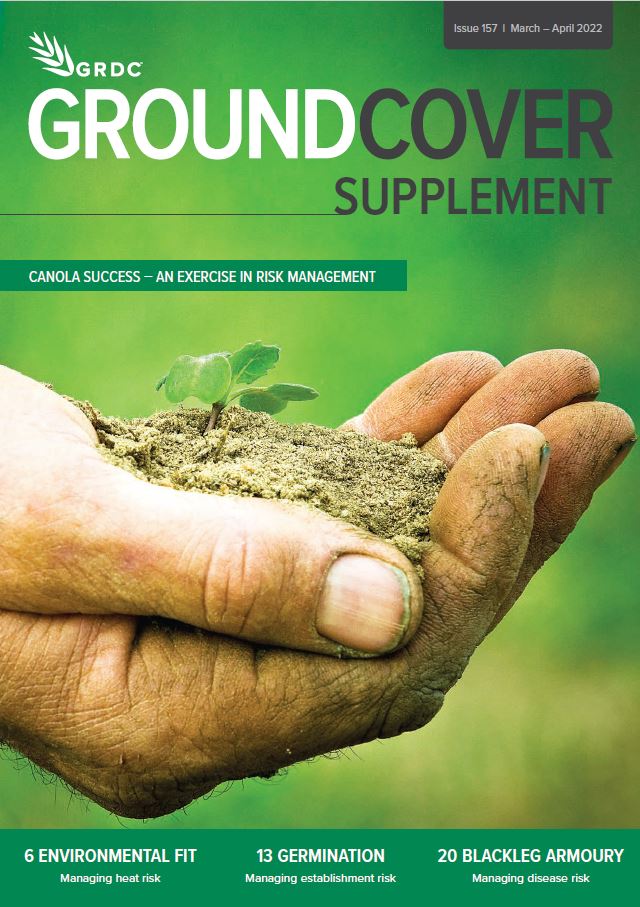This page shows the articles in of GroundCover.
GroundCover is also distributed every two months via mail. If you would like to subscribe to receive the hardcopy magazine, visit our subscription page.
Download supplement-

Functional design improvements for canola
Supplement: Canola Agronomy, March-April 2022 - 19 04 2022A research team from NSW Department of Primary Industries, with GRDC co-investment, is interrogating a historical collection of canola varieties to assess their plant architecture. They are testing the hypothesis that modifications in canola plant architecture provide ways to improve yield by matching plant characteristics to farming situations and environments.
-

Tactics to manage diamondback moth
Supplement: Canola Agronomy, March-April 2022 - 16 04 2022Vigilance is vital to reduce the risk of pests causing significant yield loss in canola. Surveillance – monitoring both beneficial insects and economic spray thresholds – is an important part of an integrated plan to both reduce the damage done by diamondback moth larvae and preserve insecticide efficacy.
-

Trials look to improve Sclerotinia stem rot management
Supplement: Canola Agronomy, March-April 2022 - 15 04 2022To improve management of Sclerotinia stem rot in canola, field studies have been undertaken by researchers from Curtin University’s Centre for Crop and Disease Management to learn more about the genotype by environment by management interactions driving infection. A systematic approach was used through the growing season to investigate the potential source of SSR infection and its subsequent impact on canola production.
-

Canola primed for enhanced weed control
Supplement: Canola Agronomy, March-April 2022 - 13 04 2022To reduce the reliance on herbicides, agronomic methods of boosting the competitiveness of canola are being investigated by researchers at the Australian Herbicide Resistance Initiative. Reducing row spacing, increasing canola seeding rate and using larger seed sizes have been shown to provide a competitive boost. Wider row spacing can be used with an increase in canola plant density and hybrid canola is a good option with optimum seeding rate.
-

Retained canola seed – handle with care
Supplement: Canola Agronomy, March-April 2022 - 07 04 2022A new research effort underway at the New South Wales Department of Primary Industries is looking to identify key seed characteristics that improve open-pollinated (OP) canola establishment and practices that produce these in grower retained seed lots.
-

Vigilance system key to blackleg management
Supplement: Canola Agronomy, March-April 2022 - 06 04 2022A national surveillance system keeps a watch on the blackleg threat to Australian canola production. Led by a team of researchers networking with scientists across the regions, changes in virulence of the blackleg fungal populations are monitored annually and warnings issued to growers when canola varieties with specific resistance genes threaten high disease levels.
-

Satellites recruited to inform canola harvests
Supplement: Canola Agronomy, March-April 2022 - 02 04 2022To enable better canola windrowing timing decisions, a collaborative project is underway using satellite imagery as a predictive tool for canola maturity.
-

Armoury for blackleg management strengthened
Supplement: Canola Agronomy, March-April 2022 - 31 03 2022When it comes to managing a serious disease threat to Australian canola production such as the fungus blackleg, developing an ‘armoury’ is necessary. For researchers from the University of Western Australia, the University of Melbourne and CSIRO this means collecting blackleg isolates from around the world, researching canola lines and new sources of resistance for canola and sharpening their understanding of the plant-pathogen interactions to guide management solutions.
-

Canola establishment under the scope
Supplement: Canola Agronomy, March-April 2022 - 30 03 2022The genetic basis of canola vigour and longer, stronger hypocotyls are under investigation by a team of scientists from CSIRO who are on a mission to improve emergence from deeper sowing. International canola varieties and non-oilseed types, together with Australian varieties, have been screened for these traits that later will be the subject of gene discovery and molecular marker identification for Australian canola breeders.
-

Metrics to help manage irrigated canola
Supplement: Canola Agronomy, March-April 2022 - 28 03 2022Unique risks and challenges are faced producing canola under irrigation but research by Field Applied Research, Australia aims to provide metrics for key agronomic measures as benchmarks to assist growers to better manage irrigated canola.


























































